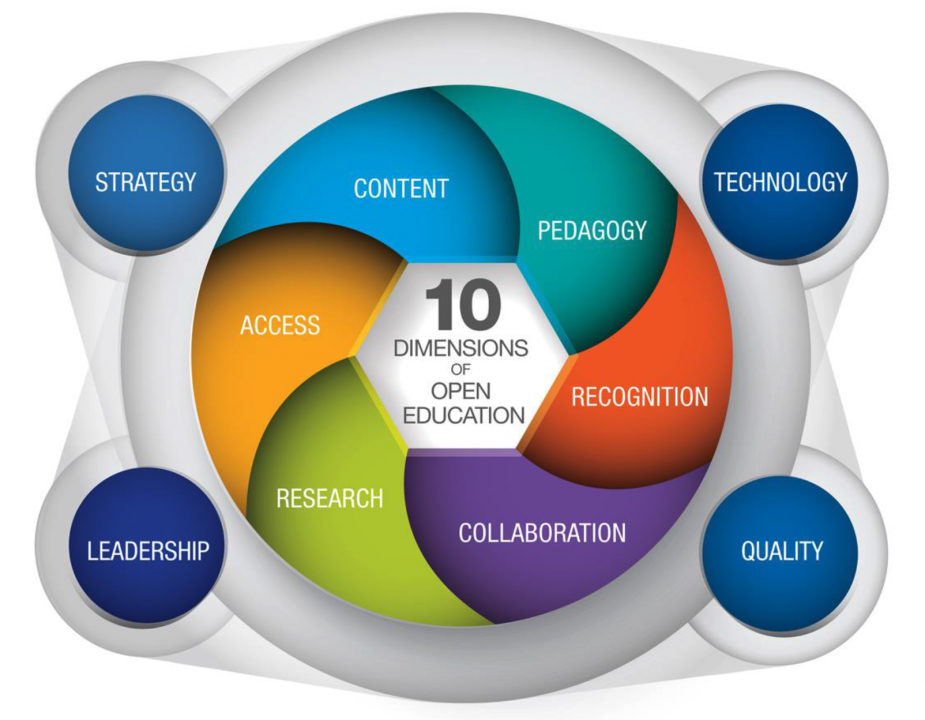A support Framework for Opening Up Education
Earlier this month the JRC-IPTS (in Seville) published the final report of their OpenEdu Project. Earlier on they published 4 other reports:
OpenCases, OpenCred, OpenSurvey and miniOpenCases.
This report is final outcomes and describes the framework they developed:
This Framework identifies 10 dimensions of open education, giving a rationale and descriptors for each. The goal is to promote transparency for collaboration and exchange of practices among higher education institutions. Without a framework, stakeholders could overlook important questions and could put effort into matters that need little further investment. It is a tool to be used mainly by higher education institutions, but it is also very relevant for EU policy makers and other types of educational institutions.
Opening up education is an item on the European agenda because of three reasons:
- it can help to reduce or remove barriers to education (e.g. cost, geography, time, entry requirements).
- it supports the modernisation of higher education in Europe, since contemporary open education is largely carried out via digital technologies.
- it opens up the possibility of bridging non-formal and formal education.
The framework can be used on different levels:
- at university management and decision makers for defining the overall strategy.
- at those staff members of HE institutions who actually design educational strategy. It offers a framework which can help them think through critical questions, such as: why is open education important and what is it exactly? What benefits can an open education strategy bring to an institution, to students (and to others out there), to a region, country or to Europe as a whole?
- at European level for relevant for policy makers since it can help them formulate policies to encourage institutions to open up education.
Framework
The OpenEdu framework consists of 10 dimensions for opening up education. It is a holistic view of open education which includes different areas where universities can be more open. Many experts (including me) were involved in the development and evaluation of the framework.

The 10 dimensions of the framework are divided into two categories: core dimensions and transversal dimensions. There are 6 core dimensions (access, content, pedagogy, recognition, collaboration and research) and 4 transversal dimensions (strategy, technology, quality and leadership). All dimensions are interrelated; the core dimensions are not more important than the transversal ones. Core dimensions represent the 'what' of open education and transversal dimensions indicate `how’ to achieve it.
| Core Dimension | |
| Access | Access in open education is the removal or lowering of economic, technological, geographical and institutional barriers which obstruct the doorway to knowledge. It grants permission to learners to engage with educational content, courses, programmes, communities of practice, networks and other types of knowledge sharing environments, media and activities in formal and non-formal education. It is also about enabling informal and independent learners to seek and get recognition of their learning. |
| Content | Content in open education refers to materials for teaching and learning, and research outputs, which are free of charge and available to all. |
| Pedagogy | Openness in pedagogy refers to the use of technologies to broaden pedagogical approaches and make the range of teaching and learning practices more transparent, sharable and visible. |
| Recognition | Recognition in open education has two meanings: a) it is the process, usually carried out by an accredited institution, of issuing a certificate, diploma or title which has formal value; b) it is also the process of formally acknowledging and accepting credentials, such as a badge, a certificate, a diploma or title issued by a third-party institution. These credentials should attest that a set of learning outcomes (e.g. knowledge, know-how, skills and/or competences) achieved by an individual has been assessed by a competent body against a predefined standard. |
| Collaboration | Collaboration in open education is about connecting individuals and institutions by facilitating the exchange of practices and resources with a view to improving education. By collaborating around and through open educational practices, universities can move beyond the typical institutional collaboration patterns and engage individuals and communities to build a bridge between informal, non-formal and formal learning. It is a live and evolving practice which is shaped by individuals according to context, goals, resources and possibilities, contributing to the lowering of barriers to education. It is therefore a concept that must be as dynamic as its practice. |
| Research | Openness in research is about removing barriers to access to data and research outputs, and also about broadening participation in research. |
| Transversal Dimensions | |
| Strategy | Strategy in open education is the creation of a unique and valuable position on openness, involving different sets of activities. |
| Technology | Technology in open education refers to technological infrastructures and software which facilitate opening up education in its different dimensions. |
| Quality | Quality in open education refers to the convergence of the 5 concepts of quality22 (efficacy, impact, availability, accuracy and excellence) with an institution's open education offer and opportunities. |
| Leadership | Leadership in open education is the promotion of sustainable open education activities and initiatives via a transparent approach from both the top-down and the bottom-up. It paves the way to creating more openness by inspiring and empowering people. |
Reference
Inamorato dos Santos, A., Punie, Y., Castaño-Muñoz, J. (2016) Opening up Education: A Support Framework for Higher Education Institutions. JRC Science for Policy Report, EUR 27938 EN; doi:10.2791/293408
No feedback yet
Form is loading...